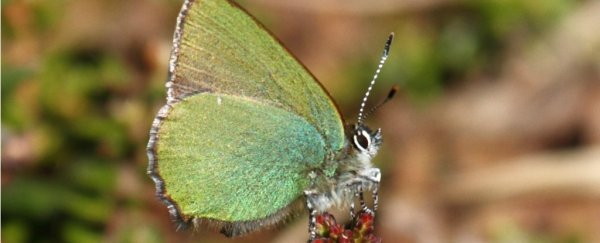When it comes to engineering, nature often pulls through with solutions that we haven't even thought of yet, like this newly discovered species of bacterium that eats plastic, and this hagfish slime that's helping researchers create super-strong and flexible hydrogels.
Now, scientists are turning to nature to figure out how to improve existing technologies, with an Australian team using butterfly wings to create a material that could build faster and stronger computer parts.
This isn't the first time that scientists have been inspired by butterfly wings. Researchers are so into them because they have a special pattern of curved intertwined surfaces on them, known as the gyroid structure.
These natural structures are incredibly strong, and they also have interesting light properties that give butterflies some of their super-vibrant colours.
Researchers from Swinburne University of Technology in Australia along with RMIT University, have made their own version of the gyroid structure, based on the intricate wing structure of the butterfly Callophrys rubi. The team says it has two distinct advantages to previous materials used to build optical computers – super-fast devices that beam information at the speed of light.
"The first is that it has improved resolution and the second is that the materials fabricated with this technique have better mechanical strength," said lead researcher Zongsong Gan. "These new gyroid structures could help make more compact light based electronics because, thanks to their smaller size, larger numbers of devices can be integrated onto a single chip."
That means that this new material can be used to control the way that light interacts with it, and therefore could be used to transmit light-based information at the speed of light around a computer chip.
And if that wasn't cool enough, the researchers created this structure using a technique called two-beam lithography to print the material at super resolution. And they couldn't afford not to – these structures are tiny. As you can see below, the holes are less than 1 micrometre thick:

The researchers think that the material they have created even trumps that of the natural gyroid structure.
"We have demonstrated the replication of 3D biomimetic gyroid nanostructures at size scales smaller than their natural counterparts," they report. "It offers more flexibility in structure design than nature, including unit cell size, filling fraction, and control of orientation and termination."
The team is looking into how their artificial gyroid could be used in new optics and photonics in the future, focusing on visible or near-ultraviolet wavelength regions – something that current materials cannot as effectively harness.
It's an exciting time for new processing and computing prospects - in the past few months, scientists have broken the record for the fastest fibre optic data transfer ever, discovered materials for quantum optical computers, and AI can now do everything from writing novels to teaching maths. What a time to be alive.
The research has been published in the journal Science Advances.
Swinburne University of Technology is a sponsor of ScienceAlert. Find out more about their innovative research.
